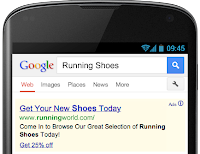The world is getting smaller. Today, people use search to shop for products and services from around the corner or across the world. This means that every business can now be a global business.
To help you connect with your customers - wherever they’re located - we’re improving the way location targeting works in AdWords. Starting the week of November 11, 2013, advertisers using either the default or ‘location of interest’ setting will be able to show ads to potential customers by taking into account both the location that people are searching for, as well as the location they are searching from -- even when they are international searches. For example, let’s say you own a hotel, and you are currently targeting Paris with the keyword “Paris hotels.” Previously, only people searching on Google.fr or Google.com from France could see your ad. Starting the week of November 11, your ads will be eligible to show to people searching for “Paris hotels” from anywhere in the world -- for example, someone who lives in New York City who is booking a vacation in Paris.
These improvements help you share your message with more customers who have expressed interest in your business and deliver a better set of results to people who are searching with locations in their intent.
Most advertisers will find that this change improves the reach of their ads with no action needed. In fact, this is currently how targeting works within countries. This update just ensures that searches across countries work in the same way. Your ads will continue to show to your target audience based on the location targeting options that you have set. In some cases you may see a change in impression volume since your ads can now show to people who are searching for your business from places where your ads weren’t previously showing.
These changes offer broader coverage for your ads while keeping your existing location options intact. If you prefer to narrow your location settings, you can still do so using advanced location options by selecting the “People in my targeted location” radio button. You can also exclude geographic locations to prevent your ads from showing in selected regions.
People are searching in ways that transcend geographical boundaries, and we want to ensure that AdWords reflects this global reality. These location targeting updates make it easier for potential customers to find your business, and easier for you to connect with them – wherever they may be looking.
Posted by Nicholas Boos, Product Manager, AdWords
To help you connect with your customers - wherever they’re located - we’re improving the way location targeting works in AdWords. Starting the week of November 11, 2013, advertisers using either the default or ‘location of interest’ setting will be able to show ads to potential customers by taking into account both the location that people are searching for, as well as the location they are searching from -- even when they are international searches. For example, let’s say you own a hotel, and you are currently targeting Paris with the keyword “Paris hotels.” Previously, only people searching on Google.fr or Google.com from France could see your ad. Starting the week of November 11, your ads will be eligible to show to people searching for “Paris hotels” from anywhere in the world -- for example, someone who lives in New York City who is booking a vacation in Paris.
These improvements help you share your message with more customers who have expressed interest in your business and deliver a better set of results to people who are searching with locations in their intent.
Most advertisers will find that this change improves the reach of their ads with no action needed. In fact, this is currently how targeting works within countries. This update just ensures that searches across countries work in the same way. Your ads will continue to show to your target audience based on the location targeting options that you have set. In some cases you may see a change in impression volume since your ads can now show to people who are searching for your business from places where your ads weren’t previously showing.
These changes offer broader coverage for your ads while keeping your existing location options intact. If you prefer to narrow your location settings, you can still do so using advanced location options by selecting the “People in my targeted location” radio button. You can also exclude geographic locations to prevent your ads from showing in selected regions.
People are searching in ways that transcend geographical boundaries, and we want to ensure that AdWords reflects this global reality. These location targeting updates make it easier for potential customers to find your business, and easier for you to connect with them – wherever they may be looking.
Posted by Nicholas Boos, Product Manager, AdWords


















.jpg)
